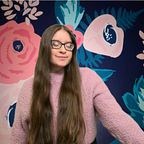Franchise Hypertextuality
Haas mentions that a wampum is “a hybridization of the oral tradition and symbolism is woven into the material rhetoric.” Where else do we see this hybridization? Where else can hypertextuality take place? What other seemingly-non-related things function similarly to hypertext? To social media?
This idea might be a mile off, but when I was trying to think of places or ways we see a hybridization of symbolism and material rhetoric, I thought of the concept of Disneybounding.
Disneybounding, from my understanding, is essentially putting an outfit together with typical clothes which resemble a Disney character; without explicitly wearing a costume and looking one hundred percent like the character. At Disney, guests over the age of 13 cannot wear costumes, but Disneybounding is a creative way to work around this rule. And, of course, if someone wants to show off their love for Disney or a particular character, wearing Disneybounding outfits doesn’t have to be limited to inside the park.
Achieving the assembling of an outfit that resembles a character generally seems to employ iconic color schemes and perhaps incorporating other symbolic nods to the character, like including rose-shaped earrings in a Belle-inspired Disneybounding outfit, for instance.
By and large, these outfits can appear as nothing more than everyday looks to the average person, especially, I would imagine, some of the ones inspired by more obscure characters or featuring less well-recognized color schemes. But to the eyes of a Disney fan, these outfits can easily give off ‘dressed as such-and-such character’-vibes. And seeing Disneybounding outfits worn in the context of the Disney parks can help make the symbolism behind the look pop out even more clearly.
As far as other examples of hypertextuality, possibly one of the most hypertextualized franchises is Harry Potter, originally a stand-alone seven-book series by J.K. Rowling. But as time has gone on? There are film adaptations. There are LEGO Harry Potter video games and toy brick sets. There’s all kinds of apparel and merchandise, both official merch and fan-made on Etsy-like shops, designed with inspiration from the characters, the Hogwarts houses, anything and everything from the wizarding world.
And the Harry Potter fanfiction, galore! Stories that fans write to expand upon the books’ contents or alter them to meet different readers preferred happenings, alternative relationships amongst characters, and such. And The Wizarding World website, formerly known as Pottermore, cannot be forgotten in all this, too. And there are unofficial books by Media Lab Books compiling books or spells or creatures from the whole expanse of Rowling-inspired magical stories.
The list goes on and on with the vast amounts of hypertextual fan-based, unofficial Harry Potter-lore present online and social media; it’s pretty much a whole culture to some — a lot of — people. So while each Harry Potter-related media or other material can be understood to an extent by anyone regardless of their knowledge about Rowling’s books, the more knowledgeable or tied to the fandom one is, the more meaning much of these things can have.
